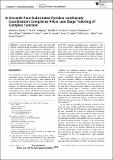Files in this item
Versatile para-substituted pyridine lanthanide coordination complexes allow late stage tailoring of complex function
Item metadata
| dc.contributor.author | Starck, Matthieu | |
| dc.contributor.author | Fradgley, Jack | |
| dc.contributor.author | De Rosa, Davide F | |
| dc.contributor.author | Batsanov, Andrei | |
| dc.contributor.author | Papa, Maria | |
| dc.contributor.author | Taylor, Michael | |
| dc.contributor.author | Lovett, Janet | |
| dc.contributor.author | Lutter, Jacob | |
| dc.contributor.author | Allen, Matthew | |
| dc.contributor.author | Parker, David | |
| dc.date.accessioned | 2021-11-17T13:30:08Z | |
| dc.date.available | 2021-11-17T13:30:08Z | |
| dc.date.issued | 2021-11-16 | |
| dc.identifier | 276564937 | |
| dc.identifier | 06e219d0-93cf-442b-8dac-2d10a1551c93 | |
| dc.identifier | 85119002063 | |
| dc.identifier | 000718930800001 | |
| dc.identifier.citation | Starck , M , Fradgley , J , De Rosa , D F , Batsanov , A , Papa , M , Taylor , M , Lovett , J , Lutter , J , Allen , M & Parker , D 2021 , ' Versatile para-substituted pyridine lanthanide coordination complexes allow late stage tailoring of complex function ' , Chemistry - A European Journal , vol. Early View . https://doi.org/10.1002/chem.202103243 | en |
| dc.identifier.issn | 0947-6539 | |
| dc.identifier.other | RIS: urn:6FAE723EEF07AF0F790F4D5027FE6478 | |
| dc.identifier.other | ORCID: /0000-0002-3561-450X/work/103511082 | |
| dc.identifier.uri | https://hdl.handle.net/10023/24350 | |
| dc.description | We thank EPSRC, (EP/L01212X/1), for grant support, Cisbio Bioassays for partial studentship support (JDF), and the European Commission for their support (DFR) under an ITN (HEL4CHIROLED 859752). JEL thanks the Royal Society for a University Research Fellowship and doctoral support for MP, BBSRC for BB/T017740/1. MJT thanks EPSRC for doctoral funding (EP/M508214/1). JCL and MJA gratefully acknowledge support from the National Institutes of Health (R01 EB027103). | en |
| dc.description.abstract | A series of cationic and neutral p-Br and p-NO2 pyridine substituted Eu(III) and Gd(III) coordination complexes serve as versatile synthetic intermediates. Nucleophilic aromatic substitution occurs readily at the para position under mild conditions, allowing C–N and C–C bond forming reactions to take place, permitting the introduction of azide, amino and alkynyl substituents. For Eu(III) complexes, this approach allows late stage tuning of absorption and emission spectral properties, exemplified by the lowering of the energy of an LMCT transtion accompanied by a reduction in the Eu-Npy bond length. Additionally, these complexes provide direct access to the corresponding Eu(II) analogues. With the Gd(III) series, the nature of the p-substituent does not significantly change the EPR properties (linewidth, relaxation times), as required for their development as EPR spin probes that can be readily conjugated to biomolecules under mild conditions. | |
| dc.format.extent | 7 | |
| dc.format.extent | 2554756 | |
| dc.language.iso | eng | |
| dc.relation.ispartof | Chemistry - A European Journal | en |
| dc.subject | Europium | en |
| dc.subject | Gadolinium | en |
| dc.subject | Luminescence | en |
| dc.subject | EPR | en |
| dc.subject | QD Chemistry | en |
| dc.subject | DAS | en |
| dc.subject.lcc | QD | en |
| dc.title | Versatile para-substituted pyridine lanthanide coordination complexes allow late stage tailoring of complex function | en |
| dc.type | Journal article | en |
| dc.contributor.sponsor | BBSRC | en |
| dc.contributor.institution | University of St Andrews. School of Physics and Astronomy | en |
| dc.contributor.institution | University of St Andrews. Biomedical Sciences Research Complex | en |
| dc.identifier.doi | 10.1002/chem.202103243 | |
| dc.description.status | Peer reviewed | en |
| dc.identifier.grantnumber | BB/T017740/1 | en |
This item appears in the following Collection(s)
Items in the St Andrews Research Repository are protected by copyright, with all rights reserved, unless otherwise indicated.

